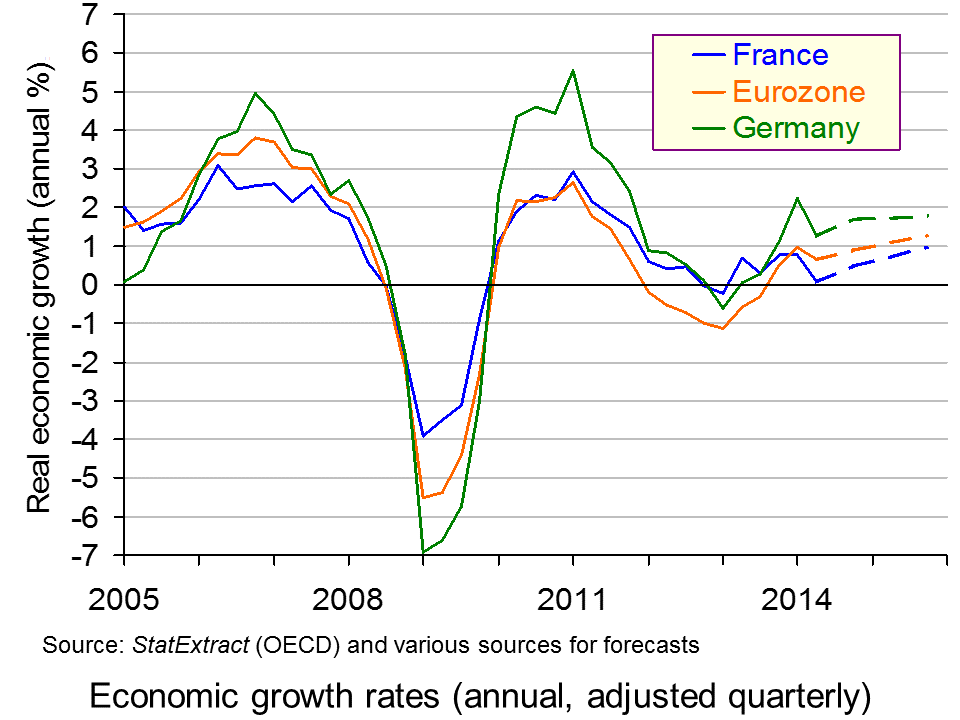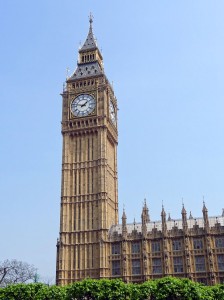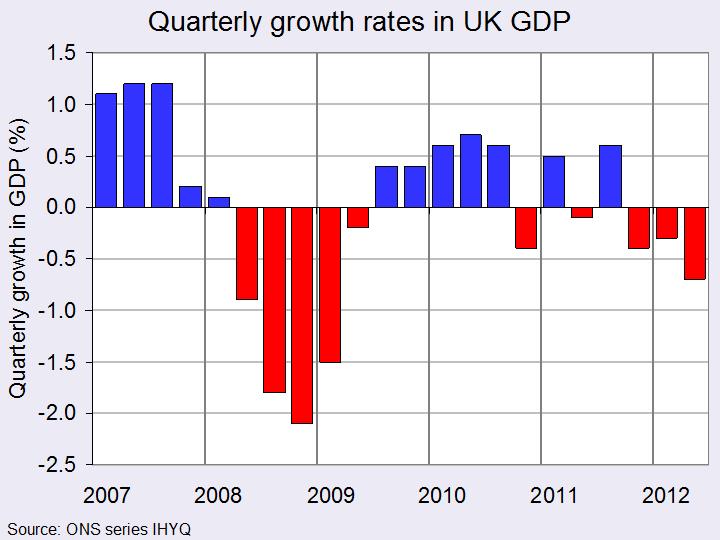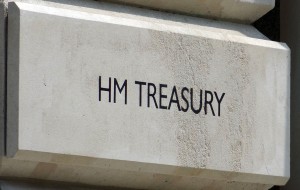 The French economy is flatlining. It has just recorded the second quarter of zero economic growth, with growth averaging just 0.02% over the past 12 months. What is more, the budget deficit is rising, not falling. In April this year, the French finance minister said that the deficit would fall from 4.3% in 2013 to 3.8% in 2014 and to the eurozone ceiling of 3% in 2015. He is now predicting that it will rise this year to 4.4% and not reach the 3% target until 2017.
The French economy is flatlining. It has just recorded the second quarter of zero economic growth, with growth averaging just 0.02% over the past 12 months. What is more, the budget deficit is rising, not falling. In April this year, the French finance minister said that the deficit would fall from 4.3% in 2013 to 3.8% in 2014 and to the eurozone ceiling of 3% in 2015. He is now predicting that it will rise this year to 4.4% and not reach the 3% target until 2017.
The deficit is rising because a flatlining economy is not generating sufficient tax revenues. What is more, expenditure on unemployment benefits and other social protection is rising as unemployment has risen, now standing at a record 10.3%.

And it is not just the current economic situation that is poor; the outlook is poor too. The confidence of French companies is low and falling, and investment plans are muted. President Hollande has pledged to cut payroll taxes to help firms, but so far this has not encouraged firms to invest more.
So what can the French government do? And what can the EU as a whole do to help revive not just the French economy but most of the rest of the eurozone, which is also suffering from zero, or near zero, growth?
There are two quite different sets of remedies being proposed.

The first comes from the German government and increasingly from the French government too. This is to stick to the austerity plans: to get the deficit down; to reduce the size of government in order to prevent crowding out; and to institute market-orientated supply-side policies that are business friendly, such as reducing business regulation. Business leaders in France, who generally back this approach, have called for reducing the number of public holidays and scrapping the maximum 35-hour working week. They are also seeking reduced business taxes, financed by reducing various benefits.
Increasingly President Hollande is moving towards a more business-friendly set of policies. Under his government’s ‘Responsibility Pact’, a €40 billion package of tax breaks for business will be financed through €50 billion of cuts in public spending. To carry through these policies he has appointed an ex-investment banker, Emmanuel Macron, as economy minister. He replaces Arnaud Montebourg, who roundly criticised government austerity policy and called for policies to boost aggregate demand.

This brings us to the alternative set of remedies. These focus on stimulating aggregate demand through greater infrastructure investment and cutting taxes more generally (not just for business). The central argument is that growth must come first and that this will then generate the tax revenues and reductions in unemployment that will then allow the deficit to be brought down. Only when economic growth is firmly established should measures be taken to cut government expenditure in an attempt to reduce the structural deficit.
There are also compromise policies being proposed from the centre. These include measures to stimulate aggregate demand, mainly through tax cuts, accompanied by supply-side policies, whether market orientated or interventionist.

As Europe continues to struggle to achieve recovery, so the debate is getting harsher. Monetary policy alone may not be sufficient to bring recovery. Although the ECB has taken a number of measures to stimulate demand, so far they have been to little avail. As long as business confidence remains low, making increased liquidity available to banks at interest rates close to zero will not make banks more willing to lend to business, or businesses more willing to borrow. Calls for an end, or at least a temporary halt, to austerity are thus getting louder. At the same time, calls for sticking to austerity and tackling excessive government spending are also getting louder.
Articles
Hollande entrusts French economy to ex-banker Macron Reuters, Ingrid Melander and Jean-Baptiste Vey (26/8/14)
France’s new Minister of the Economy Emmanuel Macron described by left-wingers as a ‘copy-and-paste Tony Blair’ Independent, John Lichfield (28/8/14)
Merkel praises France’s economic reform plans after Berlin talks with PM Valls Deutsche Welle (22/9/14)
French economy flat-lines as business activity falters Reuters, Leigh Thomas (23/9/14)
French public finances: Rétropédalage The Economist (13/9/14)
French employer group urges ‘shock therapy’ for economy Reuters (24/9/14)
Last chance to save France: loosen 35-hour week and cut public holidays, say bosses The Telegraph (24/9/14)
‘Sick’ France’s economy is stricken by unemployment ‘fever’ The Telegraph (17/9/14)
France’s economics ills worsen but all remedies appear unpalatable The Observer, Larry Elliott and Anne Penketh (31/8/14)
The Fall of France The New York Times, Paul Krugman (28/8/14)
Why Europe is terrified of deflation Salon, Paul Ames (20/9/14)
Europe’s Greater Depression is worse than the 1930s The Washington Post, Matt O’Brien (14/8/14)
Worse than the 1930s: Europe’s recession is really a depression The Washington Post, Matt O’Brien (20/8/14)
Eurozone business growth slows in September, PMI survey finds BBC News (23/9/14)
Europe must ‘boost demand’ to revive economy, US warns BBC News (21/9/14)
Valls says France would never ask Germany to solve its problems Reuters, Annika Breidthardt and Michelle Martin (23/9/14)
The euro-zone economy: Asset-backed indolence The Economist (11/9/14)
Data
Annual macro-economic database (AMECO) Economic and Financial Affairs DG, European Commission
Business and Consumer Surveys Times Series Economic and Financial Affairs DG, European Commission
StatExtracts OECD
Statistics database European Central Bank
Questions
- What types of supply-side reforms would be consistent with the German government’s vision of solving Europe’s low growth problem?
- How could a Keynesian policy of reflation be consistent with getting France’s deficit down to the 3% of GDP limit as specified in the Stability and Growth Pact (see)?
- What is meant by (a) financial crowding out and (b) resource crowding out? Would reflationary fiscal policy in France lead to either form of crowding out? How would it be affected by the monetary stance of the ECB?
- Give examples of market-orientated and interventionist supply-side policies.
- What is meant by the terms ‘cyclical budget deficit’ and ‘structural budget deficit’. Could demand-side policy affect the structural deficit?
- Using the European Commission’s Business and Consumer Surveys find our what has happened to business and consumer confidence in France over the past few months.
- How important is business and consumer confidence in determining economic growth in (a) the short term and (b) the long term?
 New data released on 25/7/12 by the Office for National Statistics showed that the UK economy shrank by a further 0.7% in the second quarter of 2012. This makes it the third quarter in a row in which GDP has fallen – and it is the steepest fall of the three. Faced with this, should the government simply maintain the status quo, or does it need to take new action?
New data released on 25/7/12 by the Office for National Statistics showed that the UK economy shrank by a further 0.7% in the second quarter of 2012. This makes it the third quarter in a row in which GDP has fallen – and it is the steepest fall of the three. Faced with this, should the government simply maintain the status quo, or does it need to take new action?
The construction sector declined the most steeply, with construction output 5.2% down on the previous quarter, which in turn was 4.9% down on the quarter previous to that. The output of the production industries as a whole fell by 1.3% and the service sector fell by 0.1%. (For a PowerPoint of the following chart, click here.)

The immediate cause of the decline in GDP has been a decline in real aggregate demand, but the reasons for this are several. Consumer demand has fallen because of the squeeze on real wages, partly the result of low nominal pre-tax wage increases and partly the result of inflation and tax rises; the government’s austerity programme is holding back a growth in government expenditure; export growth has been constrained by a slowing down in the global economy and especially in the eurozone, the UK’s major trading partner; and investment is being held back by the pessimism of investors about recovery in the economy and difficulties in raising finance.
So what can be done about it?
Monetary policy is already being used to stimulate demand, but to little effect (see Pushing on a string. Despite record low interest rates and a large increase in narrow money through quantitative easing, broad money is falling as bank lending remains low. This is caused partly by a reluctance of banks to lend as they seek to increase their capital and liquidity ratios, and partly by a reluctance of people to borrow as individuals seek to reduce their debts and as firms are pessimistic about investing. But perhaps even more quantitative easing might go some way to stimulating lending.

Fiscal policy might seem the obvious alternative. The problem here is that the government is committed to reducing the public-sector deficit and is worried that if it eases up on this commitment, this would play badly with credit rating agencies. Indeed, on 27/7/12, Standard & Poor’s, one of the three global credit rating agencies, confirmed the UK’s triple A rating, but stated that “We could lower the ratings in particular if the pace and extent of fiscal consolidation slows beyond what we currently expect.” Nevertheless, critics of the government maintain that this is a risk worth taking.
The following articles look at the causes of the current double-dip recession, the deepest and most prolonged for over 100 years. They also look at what options are open to the government to get the economy growing again.
Articles
Britain shrinks again The Economist (25/7/12)
Shock 0.7% fall in UK GDP deepens double-dip recession Guardian, Larry Elliott (25/7/12)
UK GDP figures: expert panel verdict Guardian, Frances O’Grady, Will Hutton, Sheila Lawlor, Vicky Pryce and John Cridland (25/7/12)
GDP shock fall: UK growth in 2012 ‘inconceivable’, warn economists The Telegraph, Angela Monaghan (25/7/12)
UK recession deepens after 0.7% fall in GDP BBC News (25/7/12)
UK economy: Why is it shrinking? BBC News (25/7/12)
UK GDP: A nasty surprise and a puzzle BBC News, Stephanie Flanders (25/7/12)
Tough choices for Mr Osborne BBC News, Stephanie Flanders (26/7/12)
David Cameron in pledge to control UK’s debt Independent, Andrew Woodcock and James Tapsfield (26/7/12)
David Cameron defends economic policies BBC News (26/7/12)
The GDP number is awful – and it’s the product of the Government’s amateur policies, not the euro crisis The Telegraph, Thomas Pascoe (25/7/12)
UK recession: have we heard it all before? Guardian, Duncan Weldon (25/7/12)
US economic growth slows in second quarter BBC News (27/7/12)
GDP data trigger debate on economy Financial Times, Norma Cohen and Sarah O’Connor (25/7/12)
Does weak UK growth warrant more QE? Financial Times (25/7/12)
The recession: Osborne’s mess Guardian editorial (25/7/12)
Data
Gross Domestic Product, Preliminary Estimate, Q2 2012 ONS (25/7/12)
Preliminary Estimate of GDP – Time Series Dataset 2012 Q2 ONS (25/7/12)
Questions
- What are the causes of the deepening of the current recession in the UK?
- Search for data on other G7 countries and compare the UK’s performance with that of the other six countries (see, for example, the OECD’s StatExtracts.
- Compare the approach of George Osborne with that of Neville Chamberlain in 1932, during the Great Depression.
- Does weak UK growth warrant more quantitative easing by the Bank of England?
- To what extent can fiscal policy be used to stimulate the economy without deepening the public-sector deficit in the short term?
- What is meant by ‘crowding out’? If fiscal policy were used to stimulate demand, to what extent would this cause crowding out?
The debate about how much and how fast to cut the deficit has often been presented as a replaying of the debates of the 1920s and 30s between Keynes and the Treasury.
The justification for fiscal expansion to tackle the recession in 2008/9 was portrayed as classic Keynesianism. The problem was seen as a short-term one of a lack of spending. The solution was seen as one of expansionary fiscal and monetary policies. There was relatively little resistance to such stimulus packages at the time, although some warned against the inevitable growth in public-sector debt.
But now that the world economy is in recovery mode – albeit a highly faltering one in many countries – and given the huge overhang of government deficits and debts, what would Keynes advocate now? Here there is considerable disagreement.
Vince Cable, the UK Business Secretary, argues that Keynes would have supported the deficit reduction plans of the Coalition government. He would still have stressed the importance of aggregate demand, but would have argued that investor and consumer confidence, which are vital preconditions for maintaining private-sector demand, are best maintained by a credible plan to reduce the deficit. What is more, inflows of capital are again best encouraged by fiscal rectitude. As he argued in the New Statesman article below
One plausible explanation, from Olivier Blanchard of the IMF, is that the Keynesian model of fiscal policy works well enough in most conditions, but not when there is a fiscal crisis. In those circumstances, households and businesses react to increased deficits by saving more, because they expect spending cuts and tax increases in the future. At a time like this, fiscal multipliers decline and turn negative. Conversely, firm action to reduce deficits provides reassurance to spend and invest. Such arguments are sometimes described as “Ricardian equivalence” – that deficits cannot stimulate demand because of expected future tax increases.
Those on the other side are not arguing against a long-term reduction in government deficits, but rather that the speed and magnitude of cuts should depend on the state of the economy. Too much cutting and too fast would cause a reduction in aggregate demand and a consequent reduction in output. This would undermine confidence, not strengthen it. Critics of the Coalition government’s policy point to the fragile nature of the recovery and the historically low levels of consumer confidence
The following articles provide some of the more recent contributions to the debate.
Keynes would be on our side New Statesman, Vince Cable (12/1/11)
Cable’s attempt to claim Keynes is well argued — but unconvincing New Statesman, David Blanchflower and Robert Skidelsky (27/1/11)
Growth or cuts? Keynes would not back the coalition – especially over jobs Guardian, Larry Elliott (17/1/11)
People do not understand how bad the economy is Guardian, Vince Cable (20/5/11)
The Budget Battle: WWHD? (What Would Hayek Do?) AK? (And Keynes?) PBS Newshour, Paul Solman (29/4/11)
Keynes vs. Hayek, the Rematch: Keynes Responds PBS Newshour, Paul Solman (2/5/11)
On Not Reading Keynes New York Times, Paul Krugman (1/5/11)
Would a More Expansionary Fiscal Policy Be Effective Right Now? Yes: On the Invisible Bond Market and Inflation Vigilantes Once Again Blog: Grasping Reality with a Prehensile Tail, Brad DeLong (12/5/11)
 Keynes, Crisis and Monopoly Capitalism The Real News, Robert Skidelsky and Paul Jay (29/4/11)
Keynes, Crisis and Monopoly Capitalism The Real News, Robert Skidelsky and Paul Jay (29/4/11)
Questions
- What factors in the current economic environment affect the level of consumer confidence?
- What are the most important factors that will determine whether or not a policy of fiscal consolidation will drive the economy back into recession?
- How expansionary is monetary policy at the moment? Is it enough simply to answer this question by reference to central bank repo rates?
- What degree of crowding out would be likely to result from an expansionary fiscal policy in the current economic environment? If confidence is adversely affected by expansionary fiscal policy, would this represent a form of crowding out?
- Why may fiscal multipliers have ‘turned negative’?
- For what reasons might a tight fiscal policy lead to an increase in aggregate demand?
- Your turn: what would Keynes have done in the current macroeconomic environment?
Now the details of the Comprehensive Spending Review (CSR) are known, the comments are coming thick and fast. As we saw in the last news blog, Taking sides in the war of the cuts, economists are divided over whether the cuts will be compensated by a rise in private expenditure or whether overall aggregate demand will fall, driving the economy back into recession. As you will see in the articles below, they are still as divided as ever.
At least we know the details of the cuts. The plan is for an average cut across government departments of some 19 per cent over four years, although the size will vary enormously from department to department. The government is predicting that the effect will be about 490,000 fewer jobs in the public sector. In addition to the cuts, the retirement age is to rise to 66 for both men and women by 2020 and regulated rail fares will rise by 3% above RPI inflation for three years from 2012.
Examine the details of the measures in the articles below and consider what the effects are likely to be, both on the macro economy and on income distribution.
Articles
Spending Review: Osborne wields axe BBC News (20/10/10)
Spending Review: Q&A – what does it mean? BBC News (20/10/10)
Main points from the Comprehensive Spending Review Independent (20/10/10)
Osborne swings the welfare axe Independent, Oliver Wright (20/10/10)
Chancellor spells out austerity gamble Financial Times (20/10/10)
Easier said than done The Economist (20/10/10)
 Julian Callow Sees Consolidation in Europe Bloomberg Podcasts, Tom Keene interviews Julian Callow, chief European economist at Barclays Capital (21/10/10)
Julian Callow Sees Consolidation in Europe Bloomberg Podcasts, Tom Keene interviews Julian Callow, chief European economist at Barclays Capital (21/10/10)
Spending Review 2010: Business leaders urge clearer strategy for growth Telegraph, Louise Armitstead (20/10/10)
Spending Review 2010: George Osborne leaves markets unmoved Telegraph (20/10/10)
Spending review: Osborne gambles with the economy Guardian, Larry Elliott (20/10/10)
 Larry Elliott on George Osborne’s spending review Guardian video (20/10/10)
Larry Elliott on George Osborne’s spending review Guardian video (20/10/10)
Spending review: What the economists think Guardian (20/10/10)
Spending review: The work of a gambler Guardian editorial (20/10/10)
Spending review: economists and other experts respond Guardian, various economists (20/10/10)
Comprehensive spending review: We deserve an explanation. This wasn’t it Guardian, Aditya Chakrabortty (20/10/10)
Spending review: the winners and losers Guardian, Sam Jones (20/10/10)
All in it together? BBC News blogs, Stephanomics, Stephanie Flanders (20/10/10)
The sack: Lessons for government BBC News blogs, Peston’s Picks, Robert Peston (20/10/10)
A gamble on the economics Financial Times, Philip Stephens (20/10/10)
Q&A: the devil in the details Financial Times, Chris Giles (20/10/10)
Spending Review: Poorest Take Biggest Hit Sky News, Miranda Richardson (20/10/10)
Spending Review 2010: ‘More cuts could be needed’ Telegraph, Andy Bloxham (21/10/10)
 Cuts ‘will push UK close to recession’ BBC Today Programme, Martin Wolf and Ken Rogoff (21/10/10)
Cuts ‘will push UK close to recession’ BBC Today Programme, Martin Wolf and Ken Rogoff (21/10/10)
 Spending review cuts ‘are regressive’ BBC Today Programme, Tim Harford (21/10/10)
Spending review cuts ‘are regressive’ BBC Today Programme, Tim Harford (21/10/10)
Spending review is a full stop but history lesson is vital in economics Guardian, Larry Elliott (25/10/10)
The Spending Review document
Spending Review 2010 HM Treasury (20/10/10)
Link to HM Treasury Spending Review site
Briefing and analysis from the Institute for Fiscal Studies
Opening remarks IFS, Carl Emmerson (21/10/10)
Link to briefing presentations (PowerPoint) IFS (21/10/10)
Analysis of fiscal consolidation by the IMF
Will It Hurt? Macroeconomic Effects of Fiscal Consolidation World Economic Outlook, Chapter 3, IMF (Oct 2010)
Questions
- What is the distribution of cuts between government departments?
- To what extent can it be said that there will be a real increase in health expenditure?
- What will be the effect of the cuts and tax increases on the distribution of income?
- What will determine whether the effect of the cuts will be to stimulate or dampen economic growth (or even drive the economy back into recession)? Which do you think is most likely and on what do you base your judgement?
- Trace through the multiplier effects of the measures.
- If the effect of the cuts is to drive the economy back into recession, what should the government’s ‘Plan B’ be?
In 2008 and 2009, as the global recession deepened, so governments around the world turned to Keynesian policies. Aggregate demand had to be boosted. This meant a combination of fiscal and monetary policies. Fiscal stimulus packages were adopted, combining increased government expenditure and cuts in taxes. On the monetary policy front, central banks cut interest rates to virtually zero and expanded the money supply in bouts of quantitative easing.
The global recession turned out not to be a deep as many had feared and the Keynesian policies were hailed by many as a success.
But how the tide is turning! The combination of the recession (which reduced tax revenues and increased welfare spending) and the stimulus packages played havoc with public finances. Deficits soared. These deficits had to be financed, and increasingly credit agencies and others were asking how sustainable such deficits were over the longer term. These worries have been compounded by the perilous state of the public finances in countries such as Greece, Portugal, Ireland and Hungary. The focus has thus turned to cuts. In fact there is now an international ‘competition’ as to which country can wear the hairiest hair shirt. The new Coalition government in the UK, for example, is busy preparing the general public for deep cuts to come.
We are now seeing a re-emergence of new classical views that increased deficits, far from stimulating the economy and resulting in faster growth, largely crowd out private expenditure. To prevent this crowding out and restore confidence in financial markets, deficits must be rapidly cut, thereby allowing finance to be diverted to the private sector.
But if the contribution to aggregate demand of the public sector is to be reduced, and if consumption, the largest component of aggregate demand, is also reduced as households try to reduce their reliance on borrowing, where is the necessary rise in aggregate demand to come from? We are left with investment and net exports – the remaining two components of aggregate demand, where AD = C + G + I + (X – M).
But will firms want to invest if deficit reduction results in higher taxes, higher unemployment and less spending by the government on construction, equipment and many other private-sector goods and services. Won’t firms, fearing a decline in consumer demand, and possibly a ‘double-dip recession’, hold off from investing? As for export growth, this depends very much on growth in the rest of the world. If the rest of the world is busy making cuts too, then export growth may be very limited.
The G20, meeting in Korea on 4 June, wrestled with this problem. But the mood had definitely turned. Leaders seemed much more concerned about deficit reduction than maintaining the fiscal stimulus.
The following articles look at the arguments between Keynesians and new classicists. The disagreements between their authors reflect the disagreements between economists and between politicians about the timing and extent of cuts.
Articles
Time to plan for post-Keynesian era Financial Times, Jeffrey Sachs (7/6/10)
The Keynesian Endpoint CNBC Guest Blog, Tony Crescenzi (7/6/10)
Keynes, Recovered Boston Review, Jonathan Kirshner (May/June 2010)
How Keynes, not mining, saved us from recession Sydney Morning Herald, Ross Gittins (7/6/10)
The verdict on Keynes Asia Times, Martin Hutchinson (2/6/10)
The G20 Has Officially Voted For Global Depression Business Insider, Marshall Auerback (7/6/10)
Deficit disorder: the Keynes solution New Statesman, Robert Skidelsky (17/5/10)
Hawks v doves: economists square up over Osborne’s cuts Guardian, Phillip Inman (14/6/10)
Reports and data
OECD Economic Outlook No. 87, May 2010 (see)
Economics: Growth rising faster than expected but risks increasing too, says OECD Economic Outlook OECD (26/5/10)
Economy: responses must reflect governments’ views of national situations OECD (26/5/10)
Editorial and summary of projections OECD (26/5/10)
General assessment of the macroeconomic situation OECD (26/5/10)
Statistical Annex to OECD Economic Outlook No. 87 OECD (10/6/10)
Communiqué, Meeting of Finance Ministers and Central Bank Governors, Busan, Republic of Korea G20 (5/6/10)
Questions
- Summarise the arguments for and against making rapid cuts in public-sector deficits.
- What forms can crowding out take? Under what circumstances will a rise in public-sector deficits (a) cause and (b) not cause crowding out?
- Assess the policy measures being proposed by the G20.
- How important is confidence for the success of (a) fiscal stimulus packages and (b) deficit reduction policies in boosting economic growth?
 The French economy is flatlining. It has just recorded the second quarter of zero economic growth, with growth averaging just 0.02% over the past 12 months. What is more, the budget deficit is rising, not falling. In April this year, the French finance minister said that the deficit would fall from 4.3% in 2013 to 3.8% in 2014 and to the eurozone ceiling of 3% in 2015. He is now predicting that it will rise this year to 4.4% and not reach the 3% target until 2017.
The French economy is flatlining. It has just recorded the second quarter of zero economic growth, with growth averaging just 0.02% over the past 12 months. What is more, the budget deficit is rising, not falling. In April this year, the French finance minister said that the deficit would fall from 4.3% in 2013 to 3.8% in 2014 and to the eurozone ceiling of 3% in 2015. He is now predicting that it will rise this year to 4.4% and not reach the 3% target until 2017.






